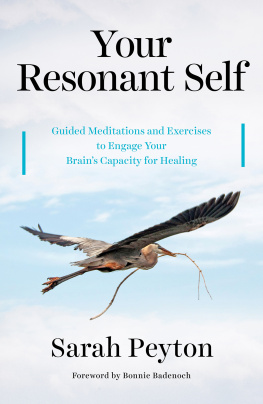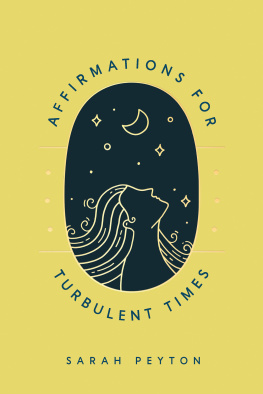
YOUR RESONANT SELF
Guided Meditations and Exercises
to Engage Your Brains Capacity for Healing
SARAH PEYTON
FOREWORD BY BONNIE BADENOCH

W.W. NORTON & COMPANY
Independent Publishers Since 1923
New York London
Note to Readers: Models and/or techniques described in this volume are illustrative
or are included for general informational purposes only; neither the publisher
nor the author(s) can guarantee the efficacy or appropriateness of any particular
recommendation in every circumstance.
Copyright 2017 by Sarah Peyton
Illustrations by emily chaffee
All rights reserved
First Edition
For information about permission to reproduce selections from this book, write to
Permissions, W. W. Norton & Company, Inc., 500 Fifth Avenue, New York, NY 10110
For information about special discounts for bulk purchases, please contact
W. W. Norton Special Sales at specialsales@wwnorton.com or 800-233-4830
Production manager: Christine Critelli
Jacket design by Adly Elewa
Cover photo by NS Loving
The Library of Congress has cataloged the printed edition as follows:
Names: Peyton, Sarah, 1962- author.
Title: Your resonant self : guided meditations and exercises to engage your brains
capacity for healing / Sarah Peyton ; foreword by Bonnie Badenoch.
Description: First edition. | New York : W.W Norton & Company, [2017] | Includes bibliographical references and index.
Identifiers: LCCN 2016058508 | ISBN 9780393712247 (hardcover)
Subjects: LCSH: MeditationTherapeutic use. | Mental healing. | Mind and body. | Neurobiology.
Classification: LCC RC489.M43 P49 2017 | DDC 616.89/1652dc23 LC record
available at https://lccn.loc.gov/2016058508
ISBN 978-0-393-71225-4 (e-book)
W. W. Norton & Company, Inc., 500 Fifth Avenue, New York, N.Y. 10110
www.wwnorton.com
W. W. Norton & Company Ltd., 15 Carlisle Street, London W1D 3BS
To Nick and Ben with gratitude, love, and tenderness.
In August of 2012, after I had spent seven years weaving together the healing that resonant words bring to emotional pain, and the deepening understanding about brains in relationship from the field of interpersonal neurobiology, three women came to me and said, Sarah, we want a book, and we want you to write it, and were going to support you to do that.
There was a flutter in my chest, a mixed-up feeling of delight, dread, and pain. I felt surprise at being offered solid support, as I felt so lonely when I was writing. Until I began this seven years journey, the inside of my head had not been a good place to live. So the thought of spending time alone with my brain in a writing process was a little scary. Had I healed enough to be able to live what I was teaching? Or would I be so relentlessly critical with myself that I would tear each sentence to shreds and never get beyond the first paragraph? I agreed with my friendsthe book needed to be written. But could I do it?
The team said they would get on the phone with me, in groups or one-on-one, so that I would be talking to them instead of writing alone, and they would take notes. They called our efforts the Dandelion Project, in honor of the way that the seeds of self-compassion are spread from person to person, where they take root, flower, and spread further.
These three women were Tamyra Freeman, the initiator of the whole idea, whose project management skills let us break down the unimaginable overwhelm of a book into doable chunks and chapters; Deb Solheim, the second team member, who has traveled with me on this journey, coteaching this material with me at the womens prison for the last six years; and Mika Maniwa, with her capacity to build and sustain warm community, who has been the central pillar of support and encouragement in breathing life into this material for the general public.
As we started the process, this team held my hand every step of the way, as if I were a toddler learning to walk. They had weekly phone sessions with me, where they would give me emotional support for my fears and my shame and then let me speak the material aloud and transcribe our conversations. As the chapters took form, they read and reread every word, supporting the book in becoming its full self.
I would not be here in any condition to write this book at all if it were not for Penny Walden, who knew everything here before I ever saw it in the research, and who remains my most beloved friend and inspiration. My husband, Matt Wood, and my younger son, Nick Wood, are my sources of delight, play, and rest, making writing possible. Susan Fusillo and Carol Ferris, there arent enough words to say what I would like to express.
During the writing of this book, my adopted son, Benjamin Brick, died at the age of thirty-two from the aftereffects of childhood trauma. I learned everything I have written about here in the hopes of stopping his trajectory. I hope that even though we lost him, this synthesis will support others in finding an easier path.
Bonnie Badenoch is my model for living this work, teaching it and writing about it. She recommended this book to Norton. Thank you, Bonnie, for being the midwife.
Neuroscience consultant Alan Fogel and Norton vice-president Deborah Malmud, Im not sure youve ever been appreciated for being doulas before, but I remain so humbly thankful for your help on this journey of birth.
And emily chaffee worked step by step with me to create the gorgeous illustrations, visiting neuroscientists and consultants to bring the most accurate and beautiful renderings of the brain possible.
Over a decade ago, I had the good luck to hear Susan Skye speak about the neuroscience of healing trauma with resonant empathy. I attended all her presentations and quickly became her apprentice for five years. She was the creator of the neuroscience and NVC New Depths program that we taught together for many years.
Dan Miller and Gloria Lybecker, thank you for your support, mentorship, and constant friendship. The same to Patrice Schanck, who didnt want to die before she saw this book, but who was taken from us by cancer on Sept. 18, 2016.
I am deeply appreciative to neuroscience researchers Michael Andresen and Laura Paret, who spent precious time to support the accuracy and clarity of several chapters of this book. Any points of inaccuracy or lack of clarity are entirely my responsibility.
To the women of Coffee Creek Correctional Facility in Oregon and the men of the Twin Rivers Unit in Washington, I am eternally indebted to you for the development of meaning and clarity in teaching this work.
To the people doing this work internationally, Olga Nguyen in Russia and Malaysia; Pernille Plantener and Joanna Berendt in Denmark and Poland; Yuko Goto, Tsyuoshi Goto, Ken Anno, and Shigeko Suzuki in Japan; Nat Fialho Bravo in Portugal; and Vera Heim and Sylvie Hoerning in Switzerland, I hope that this book provides support and nourishment.
And in North America: Amanda Blaine, Carolyn Blum, emily chaffee, Gail Donohue, Leigh Galbraith, Sandra Harrison, Satori Harrington, Clemie Hoshino, Celeste Kersey, Susan Jennings, Mika Maniwa, Jim Manske, Jori Manske, Vika Miller, Marilyn Mullen, Wendy Noel, Klarissa Oh, Mali Parke, Darilyn Platt, John Porter, Sam Qanat, Rosemary Renstad, Katherine Revoir, Peggy Smith, Sharran Szeleke, Kangs Trevens, Jessica Van Hoogevest, and Angela Watrousthank you for your empathy, your support, and your commitment to this work and to passing it on to others.
I would also like to acknowledge the crew of secondary readers: Melissa Banks, Bruce Campbell, Sofia Campbell, Susan D. Dixon, Alfred Joyell, Daniel Kingsley, Becky Lewis, Carol Lindsay, Alison McDonald, Jean McElhaney, Jonna Morgan, Dianna Myers, Nina Otazo, Bev Parsons, Carl Plesner, Shana Ritter, Rita Schmidt, Sharon Seymour, Peggy Smith, Philip D. Stewart, my beloved Carmen Votaw, and Carla Adwell Webb. Thank you for your care and your thoughtful comments.
Next page









